Categories: Featured Articles » Sharing experience
Number of views: 5519
Comments on the article: 0
How to choose an antenna for a TV: basic criteria and tips
In cities, cable television has almost completely replaced the “wireless” competitors, but there is still a demand for TV antennas. In order to receive on-air TV you need to choose a device suitable for your area in design and range. Especially often this need arises in the countryside and the private sector. In this article we will consider what are the antennas for the TV and how to choose it correctly.
The basics
Before moving on to talking about the types of television antennas, it is worth talking about the basic terms that will be used in the article.
Repeater - a device that receives and amplifies a radio signal and transmits to its subscribers. People call it a TV tower. You see her appearance in the figure below.
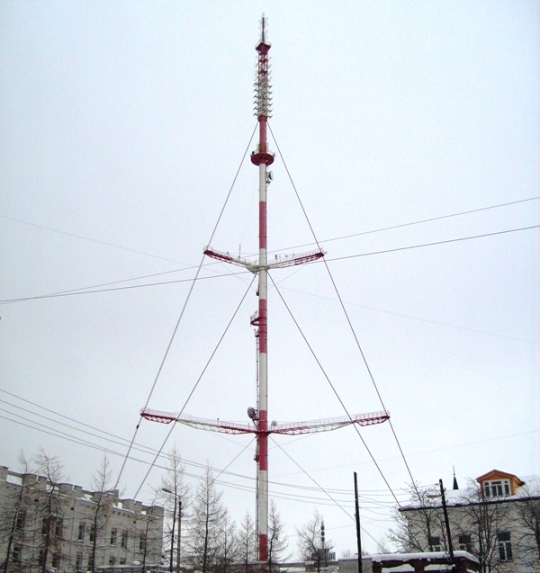
Antenna - a device for receiving or transmitting radio waves. Its main task is to convert electromagnetic waves into a signal (at reception) and vice versa (for transmission). It is connected to the receiver, in our case, to the TV. One of the main characteristics for the consumer are radiation pattern, gain and operating frequency.
Amplifier - is installed between the antenna and the receiver. The task of this device is to strengthen the frequency band of the received range. We already wrote a detailed article about them earlier.
What are the antennas?
When talking about antennas for a TV, it is not entirely rational to use the “book” classification of these devices, this is, firstly, useless, and secondly, it will be difficult for an unprepared reader. We will simplify the terminology somewhat and tell in plain language what antennas are for receiving a TV signal.
Range of received frequencies TV channels in the Russian Federation and the countries of the former Soviet Union are transmitted in meter (abbreviated as MV - frequencies from 30 to 300 MHz) and decimeter (UHF, frequencies of 300 MHz - 3 GHz). The main part of the channels is broadcast in the UHF band, and in MV - mainly local city TV.
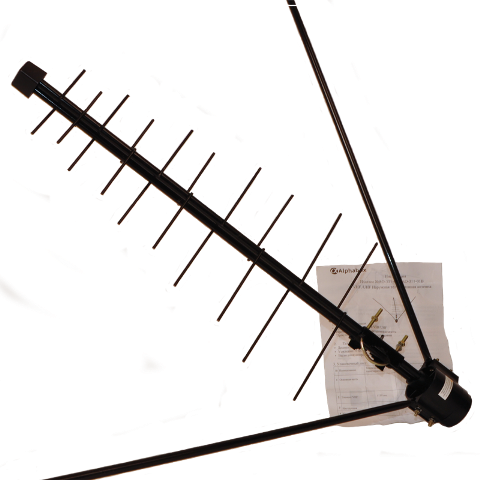
Meter antenna example

An example of antennas for receiving decimeter waves
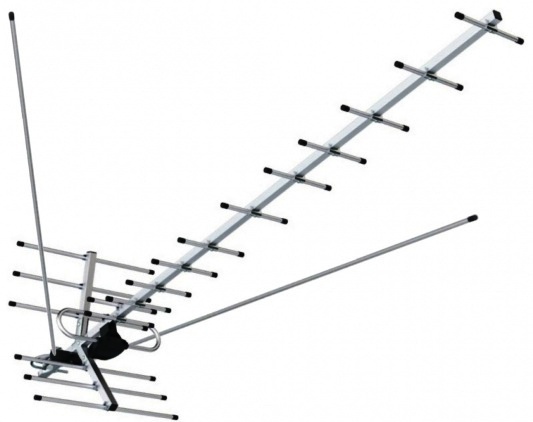
Combined Broadband Model
In general, broadband and narrowband antennas can be distinguished. But for a wide band of received frequencies you have to pay with the quality of reception.
Antenna directivity
There are omnidirectional and narrowly directed antennas. In simple terms, the direction of the antenna is its field of view, and the narrower it is, the greater the range of the antenna and you can receive a signal from a more remote repeater. Most of the television antennas are directional, that is, they must be positioned in space so that its directivity pattern looks towards the location of the repeater.
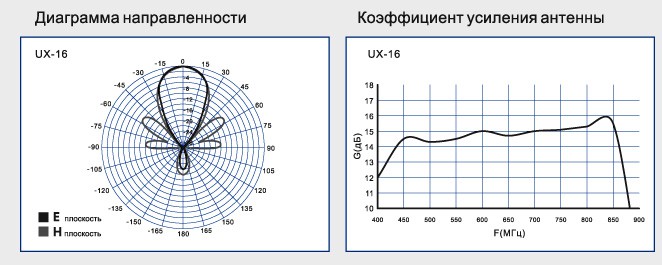
Antenna pattern and gain
Internal and external antennas
Indoor or indoor television antennas are installed indoors, such products are familiar to many from childhood. They were installed either directly on the TV, or on the nearest windowsill. Usually they looked like two "horns" - they were often pin telescopic antennas.
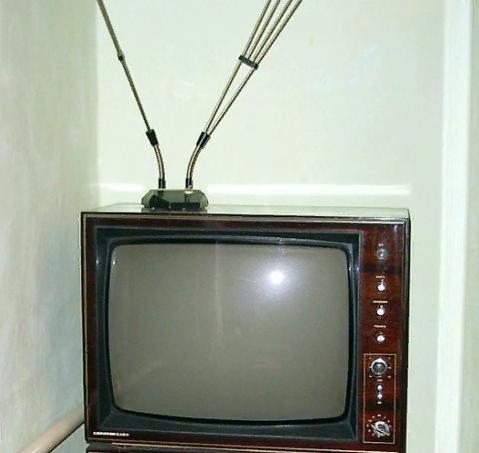
Such antennas, although convenient in that they practically do not require tuning, needed only to be connected, and perhaps slightly moving around the room, but a good signal can be achieved if the repeater is not too far away - at a distance of 15, and in the best case, up to 20 km (rare and unlikely). Although the weather influences the reception and the number of obstacles in the signal path, we will talk about this later.
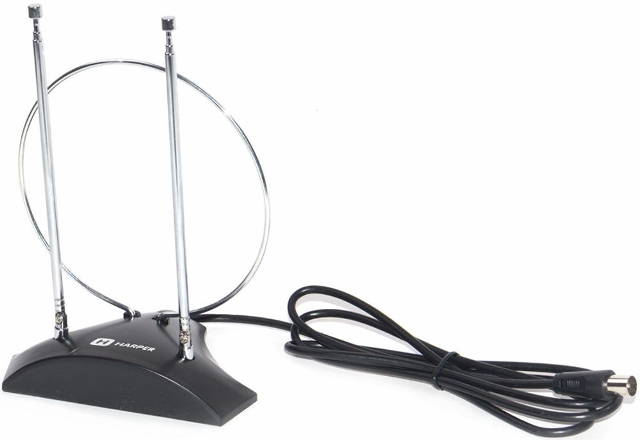
One example of a combined modern indoor TV antenna
Such antennas are divided into three types:
1. The pin. The pins can be solid and telescopic.
2. Framework. A metal frame curved into a round shape, but this is not necessarily the shape may vary
3. Combined - a combined product with pins and a frame - this turns out to achieve a greater range of reception and signal quality.
In the figure above you see a combined antenna with a frame and two telescopic pins.
Outdoor or outdoor antennas are located on the balcony, facade of the house or on its roof. In the latter version, you can precisely direct the antenna to the transmitting tower. Usually their appearance is similar to that shown in the figure below.
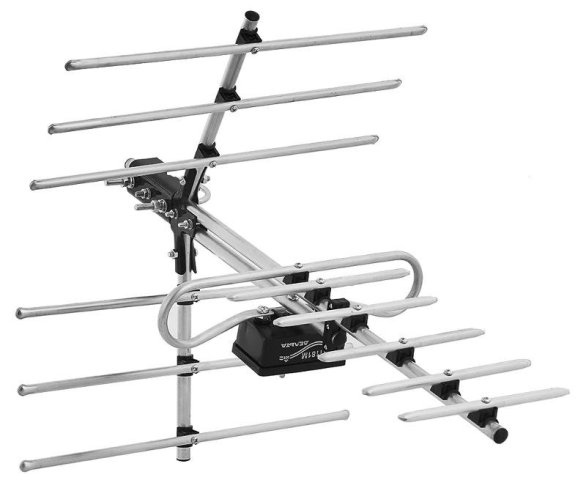
But on the modern market, not quite ordinary models are presented - flat antennas.

CIFRA-12 - an external panel directional antenna with a gain of up to 12 dBi, according to the manufacturer, it is designed to receive digital television DVB-T / DVB-T2
They are also called MIMO, panel or patch antennas. Its receiving element is either made of metal plates or is located on a printed circuit board. All other things being equal, they provide a large width of the received channel.

Active and passive
Active antennas - they install amplifier. It can be powered as from a separate 12V power supply, and 5-volt amplifiers are powered either from a power source or directly via cable from a TV or tuner, if, of course, such a function is built into them.
Passive models work without an amplifier, but the signal level from them is lower. This means that in a remote area, their reception of television channels will be either difficult or completely impossible, although this greatly depends on the design of the antenna.
Satellite
Satellite television is a separate type of transmission of a TV signal from a satellite to a corresponding antenna.
There are different frequency ranges to which the satellites transmit the signal:
-
L - 1452-1550 MHz and 1610-1710 MHz;
-
S - 1930-2700 MHz;
-
C - 3400-5250 MHz and 5725 - 7075 MHz;
-
X - 7250-8400 MHz;
-
Ku - 10.70-12.75 GHz and 12.75 - 14.80 GHz;
-
Ka - 15.40-26.50 GHz and 27.00 - 30.20 GHz;
-
K - 84.0-86.0 GHz.
Most systems operate in the C and Ku bands, and the Ka band is also popular in Europe and America. Why do you need this information? The fact is that the dimensions of the antennas decrease with increasing frequency. That is, with the same dimensions, the antenna when receiving Ku will work more efficiently than for receiving waves from the C band, and the signal will be 9.5 dB stronger than Ku. In size, the same result when receiving will give antennas 2.4-4.5 m for C and 0.6-1.5 m for Ku, respectively.
Structurally, satellite dishes resemble dishes, which is why they are called by the people. They are executed in the form of a disk concave in a parabolic shape in the center of focus of which the receiving heads are located - their correct name is the LNB converter (Low-noise block downconerter).
Satellite dishes are:
-
Steel - strong and heavy. Their advantage is that they are too afraid of shock during transportation and operation. And the disadvantage is that over time the coating may come off and they begin to rust, and also due to the heavy weight, it is necessary to provide reliable fastening for them, but this also allows for greater stability in the wind.
-
Aluminum - light. Their advantage is light weight, which means that the requirements for fastenings are not so strict. However, the softness of aluminum is a disadvantage of such antennas - they can be damaged during transportation, or, when it is already installed, as a result of shock during a storm and other things.
In form there are:
-
Direct focus. The correct round shape, which is formed as a result of the rotation of the parabola, in simple terms. The diameter can be from 0.55 to 3.7 m, they are often used in the C and Ku ranges. At small sizes, part of the receiving mirror is obscured and signal quality deteriorates. Such antennas are more often used for communication with distant satellites.
-
Offset. They are more often taken for private television reception. Their shape is slightly elongated, due to which the focus point and, consequently, the location of the receiving heads is shifted to the lower side, see the figure below.
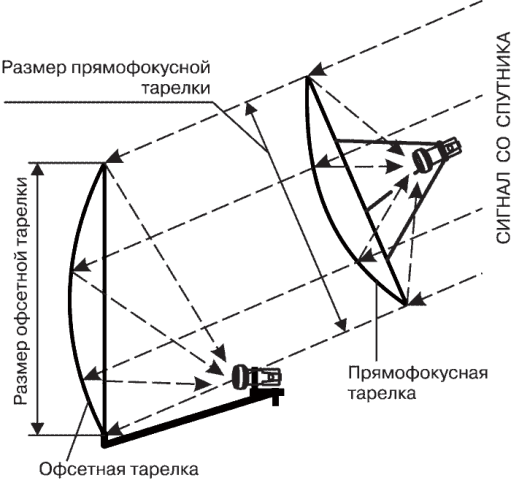
Also, satellite dishes come in various designs - solid and perforated.
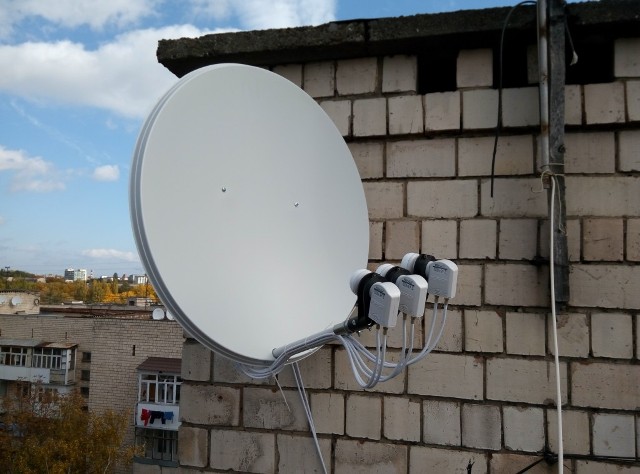
“Solid” plates are more common, and perforated ones are lighter, but more expensive and they have the advantage of self-cleaning from rain and snow. Because of the design, they are less shaken by the wind, which means that the load on the supporting structure is less and the likelihood that the direction of the antenna will be lost during a strong storm is reduced.

Satellite dishes come in different diameters and the larger the diameter, the better the signal. Therefore, the antenna model of the desired diameter is selected for the signal power at the intended location of reception.
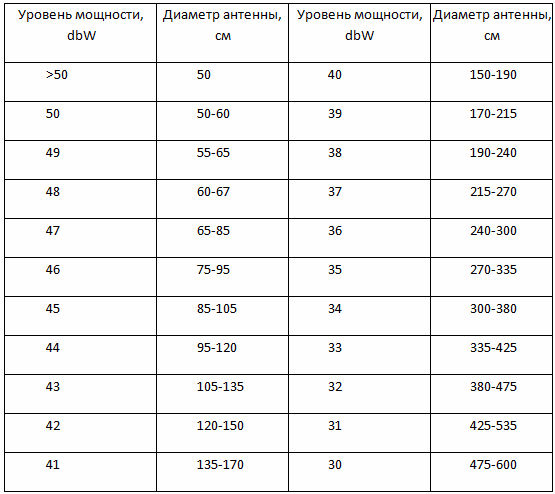
What affects the effectiveness of the reception
Let’s summarize and list the conditions that affect the quality of television signal reception.
1. Distance to the repeater. The closer - the better, but if you have an active antenna, the signal level may be too strong then the picture quality will also be poor.
2. The design and type of antenna.
3. For indoor antennas, their installation is critical - the number of walls to the outdoor. The closer to the outer wall, the more likely it is to get a good signal.
4. Installation height, direct visibility of the TV tower and the number of obstacles between the antenna and the repeater.
5. Weather conditions. In a blizzard and rain, the signal weakens.
How much does a quality TV reception cost?
To facilitate your choice, we have compiled a table of interesting models with current prices of various designs and from different cent ranges.
Satellite dishes:
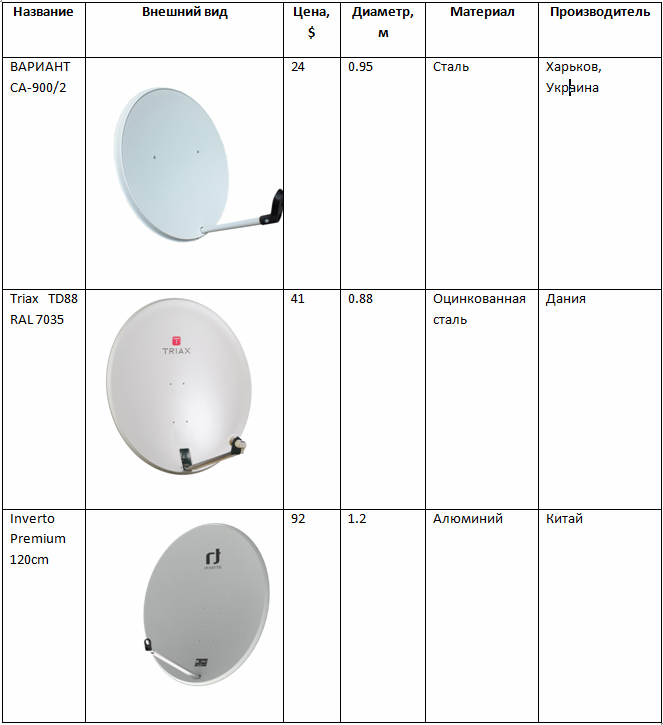
Outdoor Antennas:
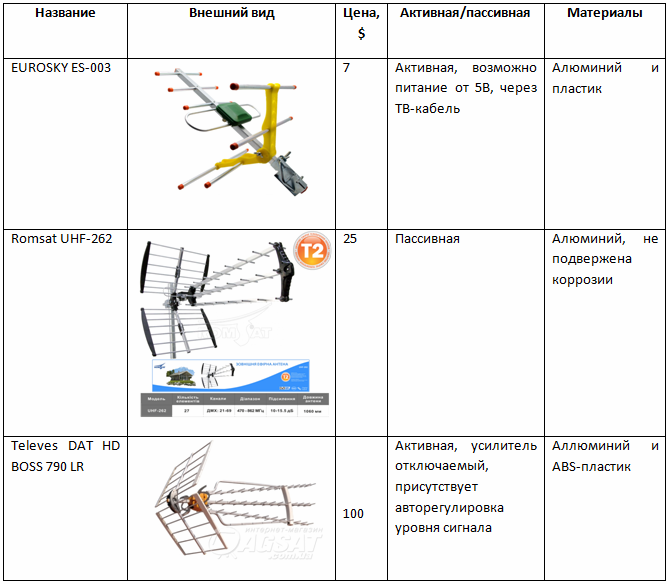
Indoor antennas:
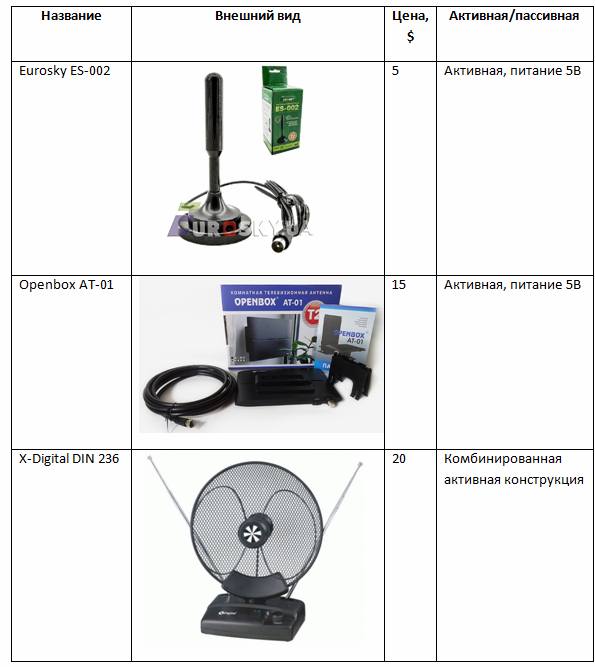
Conclusion
The information is especially relevant for residents of Ukraine. Due to the fact that there was a transition to digital broadcasting, sellers profit from the ignorance of people, sell them “special antennas for DVB-T / DVB-T2 television”. The fact is that broadcasting occurs at the same frequencies as analog, so you do not have to change anything, you just need to buy a DVB-T tuner, similar to that used with a satellite dish, by the way its name is DVB-S. In fact, the choice of television antennas is an individual matter, so we recommend visiting the thematic forums, or even easier to see what is installed at the neighbors and which direction is directed.
See also at bgv.electricianexp.com
:
